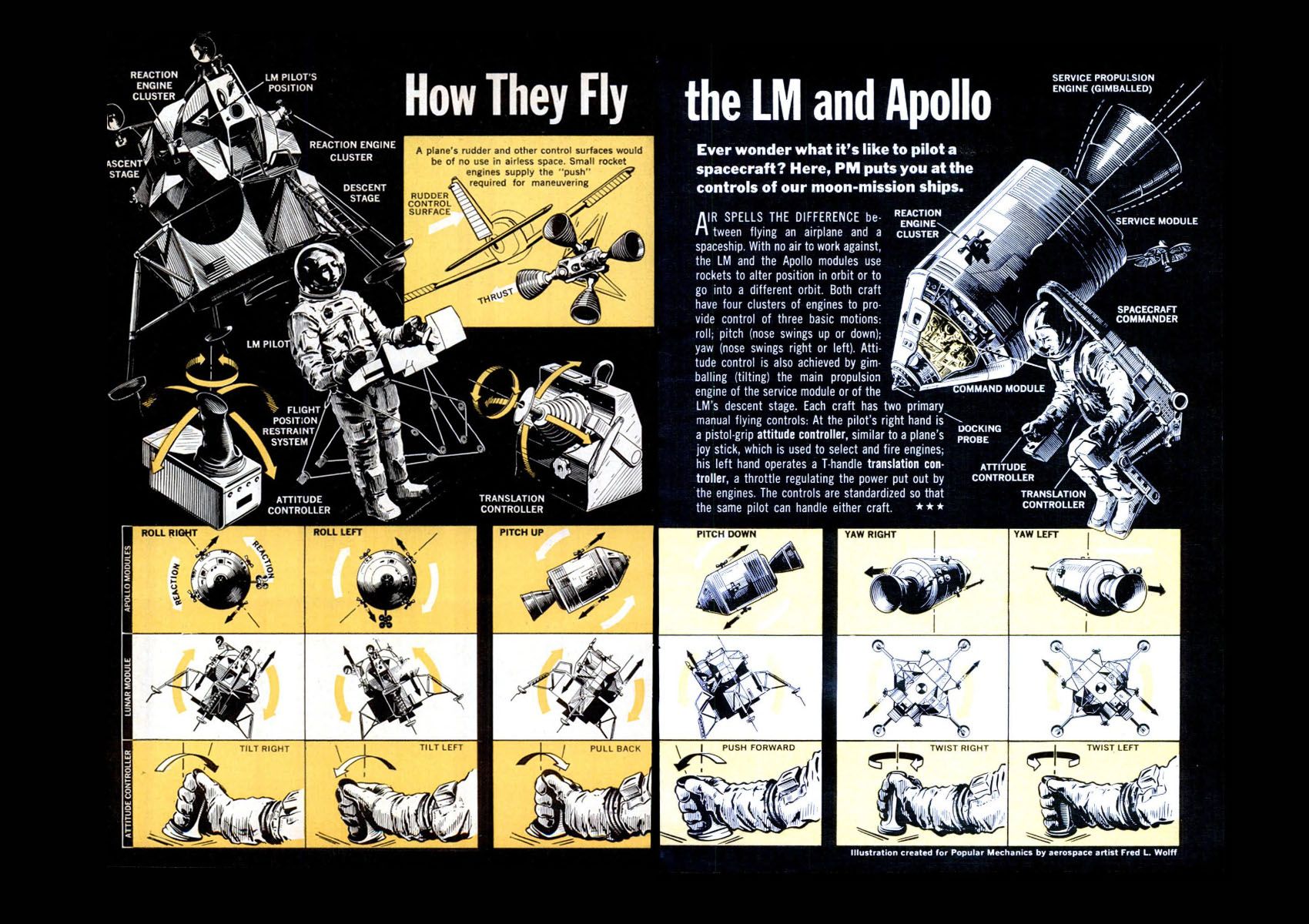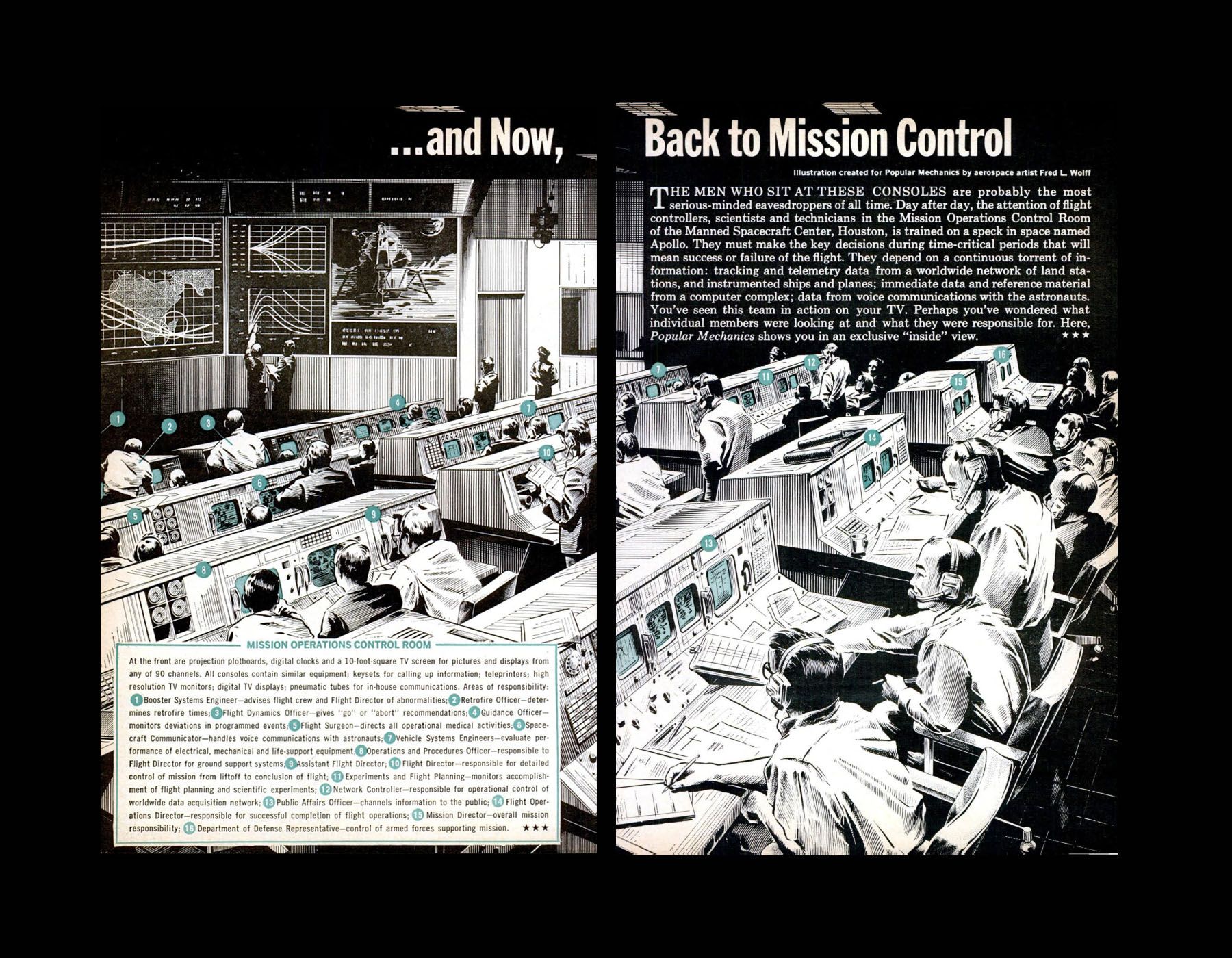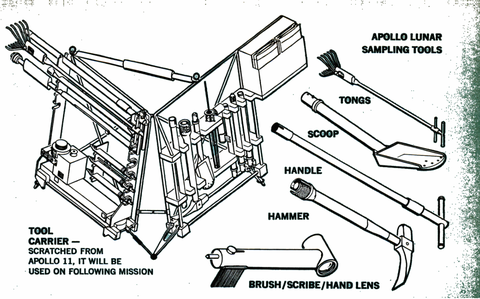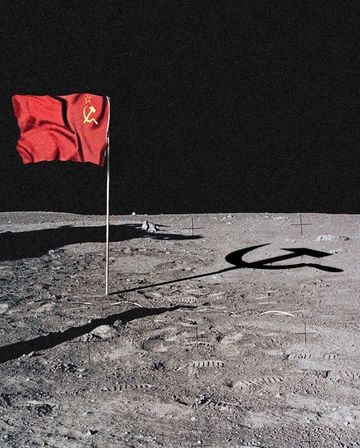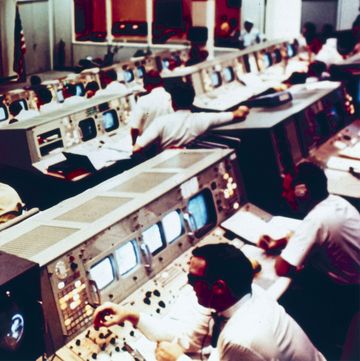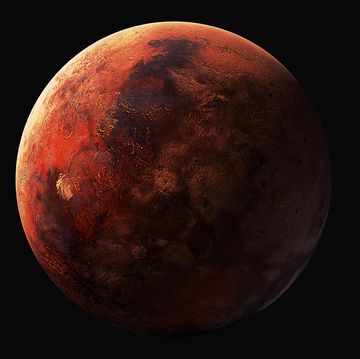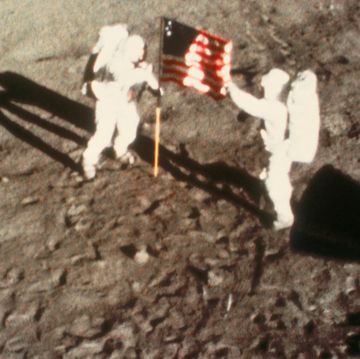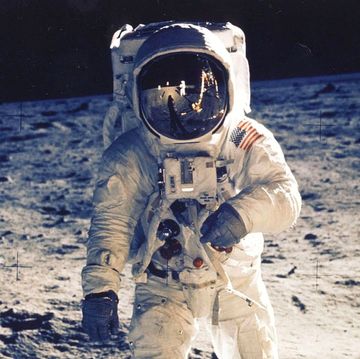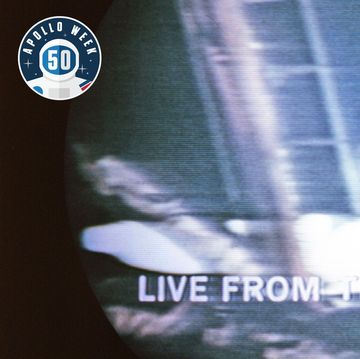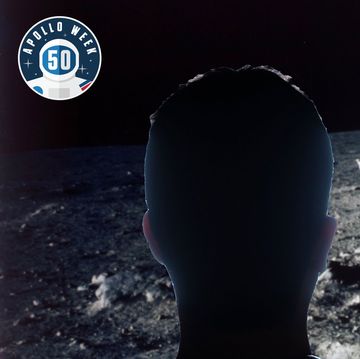Mere weeks before Apollo 11 landed on the moon, the Popular Mechanics staff imaged what humanity's first day on the moon would look like. As part of Apollo Week we're republishing the our 1969 account of the lunar landing.
It will happen any day now. In what history will record as the drama of the century, two men, after voyaging some 230,000 miles from their mother planet, will scout the first stepping stone to the solar system-our moon.
Barring a last-minute change, it will be Neil Armstrong and Buzz Aldrin who will view the arid lunar terrain as the spidery lunar module settles on the moon's surface. To get them there the United States will have devoted almost a decade of scientific effort and about $24-billion. And, the very first decision -one that has to be made within two minutes after touchdown-is whether the astronauts should come straight home.
"The way the orbits work, the ascent stage of the lunar module (LM) can blast off and reunite with the command module orbiting above within the first 120 seconds," says Dick Green, NASA's manager of the Apollo Surface Exploration Program. "In that time we've got to make sure that the fuel tanks aren't leaking, that the power is fully operative, and that no other systems are beginning to fail. If something is wrong, they come right back."
Chances are everything will function. The pair will then spend the next 22 hours on the moon, with at least two hours and—possibly closer to three—exploring the satellite's surface. The exact timetable they'll follow is, at this writing, not completely decided. Any given task can be changed, eliminated, or switched in priority.
For two hours after landing, Aldrin and Armstrong will run through a complete countdown of the LM-just as though they had already completed the mission. If any problem develops, the pair will spend time solving it. Otherwise, the countdown will end 10 minutes short of blast-off.
When NASA is satisfied that the LM is in perfect operating condition, the men will prepare for the extravehicular activity (EVA), the space agency's term for a stroll on the moon.
Getting ready for EVA is no easy matter. The men will need almost an hour to don the backpack life-support system, referred to as PLISS. When combined with the space suits, the backpacks turn the astronauts into independent, man-powered satellites that are able to operate in total vacuum and in a temperature range of from minus 250° F. to plus 325° F.
The astronauts will spend another 15 minutes checking the communications, oxygen, temperature control and other systems of their suits and backpacks; the slightest problem will scratch the EVA, If everything operates normally, NASA will radio its permission to begin man's first exploration of the moon. Here is the elapsed-time schedule:
00 Minutes. Armstrong and Aldrin switch off the LM's internal oxygen supply and open the hatch. In a fraction of a second, the compartment's interior becomes a near-perfect vacuum. The only sounds they hear are the crackle of their radios and the hum generated by backpack pumps forcing oxygen and water through their suits.
At this writing, according to a NASA announcement, it will be Neil Armstrong-the command pilot-who lowers the gold-plated sunshield on his helmet and crawls through the open hatch to a ledge just outside.
10 Minutes. For the next seven to ten minutes, Armstrong cautiously climbs down a nine-runged ladder leading from the LM's platform. Ultracautious, NASA insists that he rest almost a minute at every step, acclimating himself to working in one-sixth of Earth's gravity.
As he pauses on the third rung, Armstrong reaches to his right and pulls a D-ring handle jutting from the LM's side. A compartment called the modular equipment stowage area
(MESA) slides out from the craft's lower left side at a 45° angle. In the MESA are geological tools, scientific equipment and a TV camera.
The camera points toward the ladder and automatically begins transmitting as the MESA slides out. If the LM is within range of NASA's 85-foot dish antenna in Goldstone, Calif., we'll see on our screens Armstrong groping down the remaining six rungs to reach moon soil. If the Goldstone antenna is out of range, that historic moment will be caught by a 16-mm sequence camera at the LM's window.
20 Minutes. No one knows how low gravity and a bulky space suit inflated to 3.75 p.s.i. will affect an astronaut's movements. So, like a butterfly just emerged from its chrysalis, Armstrong's first job is to gauge stability and mobility. Holding the ladder with one hand, he gently moves alternate arms and legs, and flexes his knees.
Then comes paydirt. Carrying out a top-priority assignment, Armstrong pulls what looks like a small butterfly net with an extension handle from a roomy thigh pocket. After extending the handle, he scoops moon dust into the plastic bag at the instrument's end and stows the bag in his pocket. He throws the handle away; it is the first piece of moon litter.
"With this contingency sample of lunar soil, we'll have something from the moon even if the astronauts come back immediately after," explains NASA's Dick Green.
Armstrong next takes a few dozen photos with a battery-activated, 70-mm Hasselblad camera strung around his neck. Nasa wants him to get shots of the LM's feet, his own boots, and the terrain.
35 Minutes. During this time, technicians at NASA headquarters will be monitoring the oxygen supply, temperature, and other systems of the space suits and backpacks. They will also watch the heart and respiration rates of each astronaut-information relayed by transducers taped to the men. If NASA is satisfied with the readings, Armstrong will get word to walk the six or seven feet to the MESA.
These steps could prove a big effort. The moon's low gravity cuts friction between feet and ground, making stopping a problem. Consequently, Armstrong will adopt a shuffle to reduce momentum and avoid bouncing, a motion that could lead to a tumble.
Many NASA experts believe that working in low gravity will be exhausting. Others think that it will be easier than on Earth. No one knows for sure, and teams of NASA specialists will be eyeing Armstrong's oxygen consumption and other physiological details as he continues his assignments.
Once at the MESA, Armstrong lifts out the TV camera and a tripod, carries them 20 feet or so away, and points the camera toward the LM. Next, he sets up another tripod, also contained in the MESA, some 30 yards off. From the top of this tripod, he unrolls a sheet of ultrapure aluminum foil and points it toward the sun. The apparatus, called the solar wind composition experiment, looks like a home movie screen.
In the moon's vacuum, atoms of noble gases such as argon and krypton will be captured in the aluminum. On earth, chemical analysis of the aluminum will show how much of what gas struck the foil. This information will give physicists precious data on the composition of the solar wind that breezes through space.
Now, Armstrong makes a reconnaissance of the LM, circling the craft and taking pictures of the landing site and surrounding terrain. He ends this walking tour on the side opposite the MESA.
55 Minutes. If Goldstone and the other big antennas in NASA's network are out of optimum range, Armstrong pulls out a six-foot dish antenna folded inside a hatch of the LM's body. He unfolds it and points it toward Earth. Inside the LM, Buzz Aldrin thumbs a switch that transfers TV transmission to the highly efficient parabolic antenna just erected. One and a half seconds later, the time needed for the signal to reach Earth, home TV screens should light up with the scene of Armstrong lumbering toward the LM.
1 Hour 30 Minutes. At the MESA, Aldrin lifts what looks like a large toolbox onto a waist-high, two-foot-square table that unfolded as the MESA slid out. From the aluminum box he unloads a hammer, scoop, tongs and an extension handle that fits all the tools. The astronauts can't bend over. At most, and only in an emergency, will they kneel. So, Aldrin attaches the extension handle to the scoop, and shovels moon "gravel" into the box. When it's filled, he closes the lid and pulls the levers on metal straps around the box. Teflon seals preserve the moon vacuum inside.
1 Hour 40 Minutes. About the time Aldrin is sealing the rock box, NASA makes a crucial decision. The backpacks are designed to hold a four-hour oxygen supply. But, depending on how much oxygen the pair actually has consumed -a measure of the efforts needed to work in low gravity-and how tired they are, NASA will opt for a three-hour EVA or call a halt after two hours.
If it's a three-hour EVA, Armstrong sets up two instruments that will stay on the moon. The first is a solar-cell-powered seismometer, which he deposits 30 feet or so from the LM. The device, which stays active for more than a year, picks up any rumbles inside the moon and radios the information to Earth. Such data could provide clues to the moon's origin.
The second instrument is a panel of optical reflectors that Armstrong points toward Earth. Laser light beamed from various Earth stations and reflected by the device can be seen through telescopes. The information gleaned from these reflections will pinpoint the distance between Earth and moon, various continents and even locations within a given country.
Meanwhile, Aldrin has three important jobs to do. After shuffling some 40 feet from the LM (probably still within range of the TV camera's wide-angle lens), he'll plunge a hollow tube into moon soil. As he does so, two metal paddles will sweep away the soil's top layers, exposing a pure sample underneath. On Earth, biologists will examine the sample, automatically sealed in a plastic bag when Aldrin withdraws the tube, for evidence of microorganisms.
Next, he fills up a jar-sized container with moon pebbles. A special seal preserves a perfect vacuum, which will allow geologists to determine how much, if at all, other moon samples became altered through exposure to even a few molecules of air. The last task is to hammer a hollow tube a few inches into moon soil. This core sample may tell geologists how the sun's rays have altered minerals on the moon's surface.
2 Hours 15 Minutes. For the next half hour, the pair load up another box with lunar rocks, ambling as far as 300 feet from the LM to get a varied selection.
2 Hours 40 Minutes. The pair wind up the EVA. Armstrong walks to the solar wind experiment, folds up the aluminum foil, and puts it into the rock box, which he carries. Aldrin climbs into the LM and hauls up both rock boxes with a small pulley. Once Armstrong enters the compartment and closes the hatch, the LM is repressurized. The pair take off their backpacks and connect their suits to the LM's internal oxygen supply.
The LM can carry only about 18 extra moon pounds (equal to 108 Earth pounds) on its return to the command module. So, the men remove the film cartridges from their cameras and throw out their Hasselblads and backpacks. They seal the hatch again and repressurize the compartment.
The astronauts finish their moon stay with a meal, eight hours of rest, and another countdown of the LM. When the command module orbits to a rendezvous position, they blast off to meet it, leaving behind the descent stage of the LM plus a good deal of expensive equipment.
Man's first day on the moon has come to an end.
This article was published in the July 1969 issue of Popular Mechanics. It's been reprinted for the 50th Anniversary of Apollo 11.

